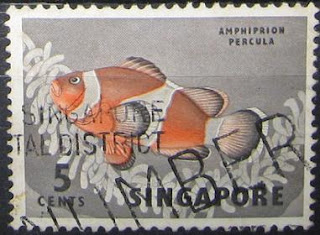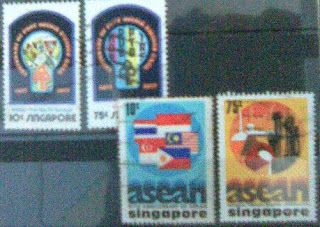We get our sources of information and updates from magazines, postal agencies, websites...etc. At times, the terms used could be a bit confusing for those who just started collecting stamps. So let me list down some of the common vocabulary that we are likely to encounter in the stamp collecting world.
Types of stamps:
Definitive - Stamp issues that are meant for use over an extended period of time, for example 3-5 years. These regular stamps will be re-printed when the stock runs out. So sometimes two different 'runs' of the same definitive series may have minute differences. Here's the early definitives from Singapore.
Commemorative - Stamp issue to mark a certain event, e.g. 150 years of postage, or 10 anniversary of some national organisations. Limited runs normally. Here's some Singapore samples, celebrating 10 years of POSB and ASEAN.
Special - Very similar to commemorative stamps, but doesn't exactly mark any one-time off events and yet has limited prints. Examples include a set of stamps on tropical fruits, for example.
Revenue stamps - Stamps used as a form of proof that some government / official fees have been paid. Sometimes other postage stamps could also be used in place of the revenue stamps.
Cinderella stamps - Stamps lookalike, but which are not meant for postage use. Examples include fund-raising stamps for charity. Here's some Cinderella stamps from SATA.
Postage Label - Machine printed labels from those self-service vending machines. The designs changed every now and then. The 'gum' is also quite hard to wash off, and so personally I don't really like these stamps. Here's some samples.
First Day Cover - a.k.a FDCs. Specially envelopes designed with each issue of new stamps that enhances the design of these new stamps. Sometimes the cancellation of the stamps are also different. Due to the humid environment in Singapore, again I don't really like to collect these FDCs because the envelope may yellow easily.
Minature Sheet - This is a specially printed stamp sheet containing a complete set of stamps. The designs of the sheets often enhances the overall appearance of the stamps. Here's a sample for 150 years of stamps celebration.
Se-tenant - Two or more different stamps which could combine to form a single design. Here's a sample, and I'm missing one of them.
Overprint - Re-printing of the original stamps to add / modify the details on the stamps, for example changing of stamp values.
Cancellation: It's that 'chop' or the 'mark' that typically strikes across the stamp to show that it has been used i.e. 'cancel'. Here's a sample where the cancellation is a festive greetings, and asking the senders to post early for the festive greeting cards.
Here's a list of terminology used to describe stamps -
Never hinged - Stamps which have never been hinged. Hinging is a practice that has since become unpopular. However, if you find stamps earlier than the 1950s, you may still come across hinged stamps.
Lightly hinged - Stamps with a slight hinged mark.
Heavily hinged - Stamps with parts of the original hinge. Not ideal.
Original gum - Stamps with the original gum intact, typically unused stamps.
Mint - Unused stamps in very good condition. Of course this is subjective, since older stamps in 'mint' condition would still look 'old'.
Used - Stamps which have been used as a postage stamp, i.e. gummed onto the envelope, cancelled, and possibly soaked off the envelope. Some people prefer used stamps while others like mint. Individual preferences I guess. For used stamps, it is better to have them with the original envelope. This is because collectors like to see the other markings on the envelopes, e.g. canellations, or other 'marks' which reveal some story about the particular letter.













No comments:
Post a Comment